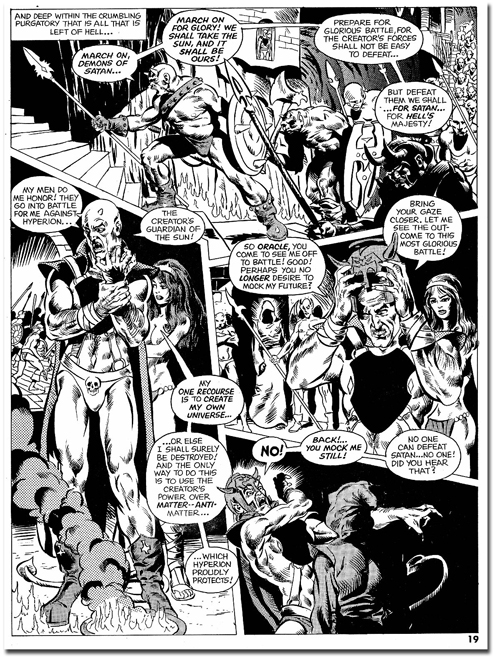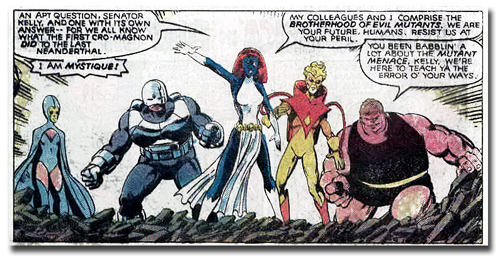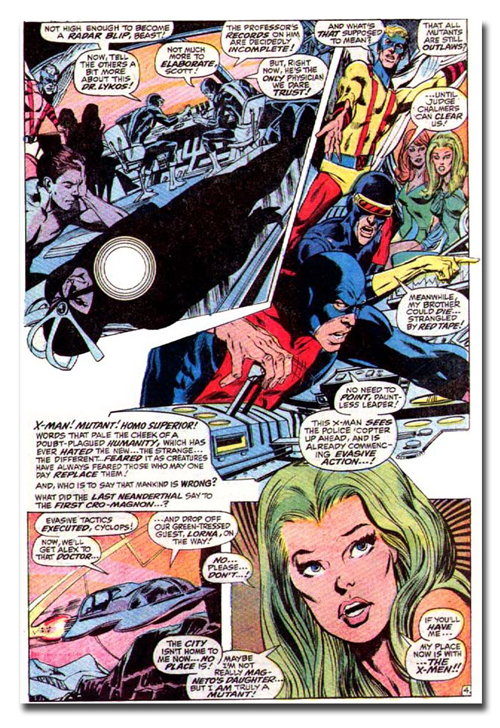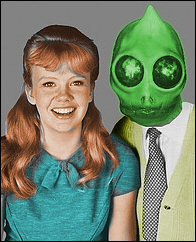One of the common practices of creators in any medium, particularly one that is often perceived as disposable by the public, is to recycle their own work into the same or other media. Writers of comic books often do this. Artistically, a reader could look at it as being done as a variation of a theme, a fleshing out of a character or idea the writer is particularly enamored of. Done well, this results in the concept of Michael Moorcock's Eternal Champion or the classic Alternate-Earth tales for the 1970s Marvel titles. Done with less skill or repeated ad nauseum you get the square-jawed hero of what one comic book forum pundit called "The Adventures of Chaykin-Man", the cookie-cutter heroes and villains of Jim Starlin and the retread plots from Michael Fleisher in stories between the publishers of Marvel, DC and Warren.

Psycho #4 (September 1971), "Out of chaos...A new beginning!" .
Skywald Publishing. Story by Marv Wolfman.
I kind of doubt that Marv Wolfman sat down and rationalized in 1977 that no one would ever notice the story he wrote for Psycho #4 in 1971 shared some elements with the story in Nova #6. While that may be the case it is likely that he had a scene in mind he particularly liked that he felt did not previously have the proper venue and exposure to do it justice. Steve Gerber used concepts from a Bloodstone tale he scripted in the finale of his Phantom Zone story in DC Comics Presents.
It could be a truism about sequential art, that if nothing new is given to the reader that grabs them every time they pick up a title they will be less likely to pick up the following issues or the tie-ins. The fickleness of many fans is one of the perils the monthly pamphlet faces today. It is not enough to have a good story told over time, each issue must blow the mind of the buyer a little more than the previous one.

Uncanny X-Men #141 (January 1981). "Days of Future Past"
Marvel Comics Group. Story by Chris Claremont.
In Uncanny X-Men #141 Mystique pauses to make an expository speech prior to a very public assassination attempt of a public figure who is campaigning for President of the United States. The speech is very similar to a caption Roy Thomas scripted for X-Men #60 several years prior.
There were some at the time who criticized Chris Claremont for "ripping off" Roy Thomas in adapting his caption from Uncanny X-Men #60. I don't agree with that assessment at all, partly because the fellow professional who most forcefully made the claim had a very public and emotional disagreement with Claremont at the time. Until relatively recently, Marvel had a long stylistic tradition of in-jokes and practiced the business model of trying to make the reader feel like one of the mythical Bullpen insiders. I was very familiar with the Thomas/Adams run and my opinion is that Mystique's declaration in issue #141 paraphrasing Thomas' original text was a part of that, a respectful hat tip that would appeal to long time readers by tickling the geek-bone and was a logical progression of X-Men story-telling. It is interesting that the particular caption that was used later by Claremont probably wouldn't even have been included in the book if not for the era's atypical Neal Adams panel layouts. Roy Thomas was often forced to write sometimes awkward space-filling text and captions for the sake of page aesthetics.
For some reason I don't find the recycling of comic book stories and plots by an author as particularly heinous as much as lazy and dangerous to the success of a project and by extension, the company that publishes it. I really liked Fleisher's Jonah Hex work for DC (the El Papagayo character being the exception) but I was dismayed by his habit of re-writing plots to use in another book. Recycling a story, when done without wit and talent is just cannibalism, a charge I have witnessed being directed at the output of Marvel more than the other companies in the last few years. To cite some more recent examples of recycling old story concepts, Joss Whedon did a story in Astonishing X-Men featuring a sentient Danger Room-entity a few years after a similar story was told using the Cerebro device as the emergent being seeking freedom. The mega-event of Civil War also appeared to me as being very like a Marvel cross-over story from the 1970s, though enough was changed that one could charitably consider it a new idea or at least one that evolved naturally from previous concepts.





























Isn't the 'neanderthal' thing just a recurring theme in the X-Men stories, the comic equivalent of the Imperial march music from the Star Wars movies that plays whenever Vader's around?
ReplyDeleteIt's sort of the inspiration for both Magneto's mutant-supremecism and the government's antagonism.
I'm not at a spot to check my resources, but I, too, recall this being more of a theme. In particular I'd re-check the first Sentinel story (circa issue #14-16) as the most likely spot for this sentiment to have aired.
ReplyDeleteAs I recall, during that earlier arc Professor X was even part of a talk show about whether or not there was a "mutant problem" to be addressed.
Still, I haven't re-read those stories in decades and could easily have applied a later expression to an earlier sentiment. The Marvel universe of the '60s and '70s was more of a home and haven to me than the real world was.
A sub-plot that is a recurring theme is a bit different than taking entire scenes written for different characters (or the same characters) and re-written nearly scene for scene and presented as new, as in the case of Fleisher or Wolfman on Psycho/Nova.
ReplyDelete